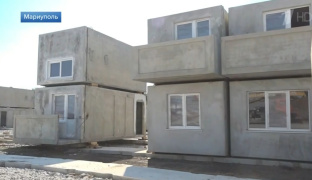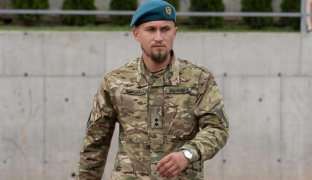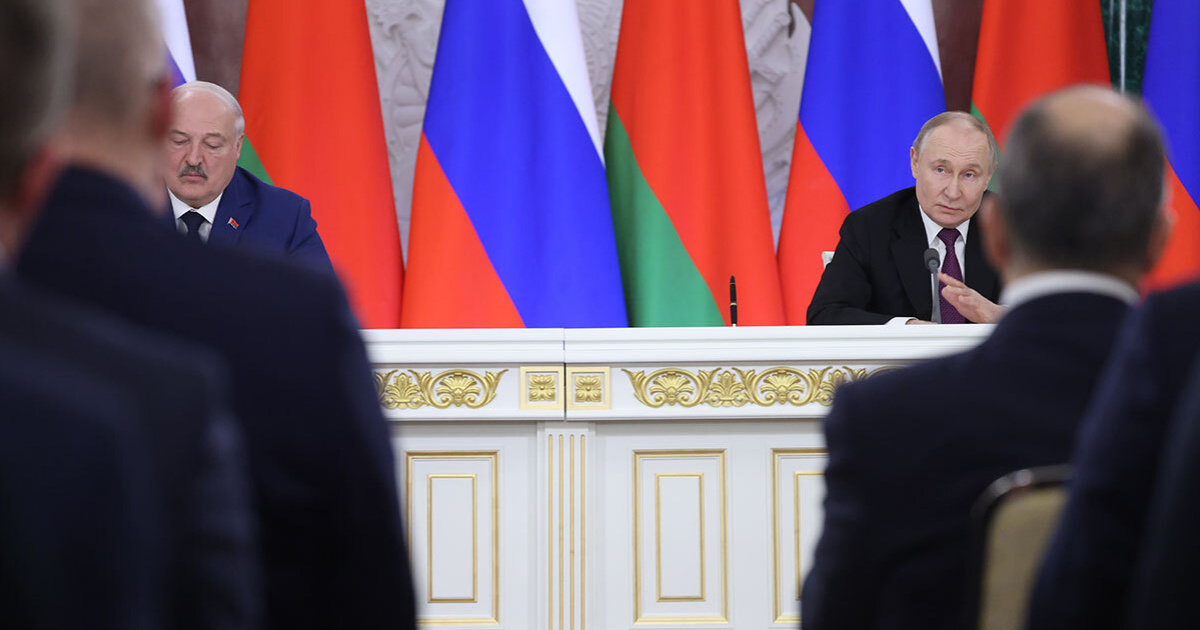Illegal export of the captured steel plants' production is the most significant source of income for occupation regimes in Donetsk and Luhansk. Even smuggling coal brings 3 times less income. But if anthracite from CADO can still be attempted to be traced by chemical composition, this option is not available for steel products.
The Kremlin's backers of the separatists, who gave metallurgy to CADLO at the mercy of Kharkiv oligarch Serhiy Kurchenko, are taking advantage of this.
Let us recall, the Vneshtorgservis company (VTS), associated with S.Kurchenko, is registered in the enclave "Republic of South Ossetia" unrecognized by the international community, in April 2017, was given control over a number of mining and smelting enterprises located in the areas of Donetsk and Luhansk oblast, seized by the militants.
These are the Alchevsk Iron & Steel Works and Alchevsk Coke and Chemical Plant, which are members of Serhiy Taruta's Industrial Union of Donbass, Stakhanov Ferroalloy Plant of the Ihor Kolomoyskyi's Privat Group, Yasynivka Cokery Plant and Donetsk Metallurgical Plant of the Donetskstal Group of Victor Nusenkis.
But Vneshtorgservis received the most assets from the grabbed Metinvest group of Rinat Akhmetov: Makiivka and Yenakiieve Iron & Steel Works, Yenakiieve and Makiivka Coke Plants, Dokuchaievsk Flux and Dolomite Plant and Khartsyzsk Pipe Plant.
Russian customs statistics show that in 2018, Vneshtorgservis was able to partially resume the operation of these enterprises.
Thus, the supply of rolled steel and pipes from Ukraine to the Russian Federation in January-November 2018 increased by 20.7% compared to the same period of 2017, to 2.11 million tons.
A small share in this volume is accounted for by the products of Interpipe pipe-metallurgical company of the Dnipropetrovsk oligarch Viktor Pinchuk: up to 30-35 thousand tons. But the most significant share of imports falls to long products and shape steel-rolled stock: 1.118 million tons, including 593 thousand tons - for wire rod and rebar. And these are the specializations of Yenakiieve and Makiivka Iron & Steel Works.
The main producer of wire rod and rebar in the territory controlled by the official Ukrainian authorities is the ArcelorMittal Kryvyi Rih Combine. However, according to its general director Paramjit Kahlon, AMKR has completely stopped deliveries to Russia since 2015.
Moreover, the Dnipro Metallurgical Plant (Kamianske, Dnipropetrovsk oblast), which is now managed by Metinvst, produces rebar and wire rod.
By the end of 2018, the DMP produced 337 thousand tons of wire rod, of which 41.26% was sold inside Ukraine, the rest went to foreign buyers.
DMP indicates Israel, Poland, the Netherlands, Moldova, Germany, Bulgaria, Brazil, Hungary, Italy, Lithuania, Romania, Serbia, Slovakia and the Czech Republic among the export destinations. Russia is not among them. In this case, 593 thousand tons is the total volume of exports from Yenakiieve and Makiivka.
The total volume of their production for the period under review is within 610-630 thousand tons – since small amounts in the "DNR" itself are taken by the Khartsyzsk Hardware Plant Silur.
There are no other significant consumers of wire rod in the "republics" themselves – based on the data of the "Ministry of Economy of the DNR" that only 8 thousand people are employed in CADO at the enterprises of the engineering industry.
In this case, the remaining 1 million tons from the export deliveries is flat products produced by the Alchevsk Iron & Steel Works. This figure coincides with the data on its work in separatist media.
According to the "LNR", from December 2017 to November 2018, steel production in Alchevsk was 1 million tons. In pre-war 2013, there was more: 3.8 million tons of rolled steel and 4.2 million tons of steel.
But of course, the current leaders in Luhansk do not focus attention on such "trifles" as a drop in indicators by 4(!) times. Especially because they personally have enough.
In general for 2018, prices for rebar decreased from $624/ton to $563/ton (on the Shanghai Futures Exchange ShFE, one of the main global indicators). But at the same time, price spikes of up to $700/ton were recorded in June and September.
The price for wire rod on the ShFE started last year from $496/ton and finished by $511/ton, but from May to October, the price was kept at around $590/ton.
Ukrainian media previously reported on the export of wire rod and rebar from CADLO: according to data based on the analysis of customs statistics, in the summer of 2018, 86.8 thousand tons were exported for the value of $35.5 million.
It turns out that the average selling price was $409/ton – this is lower than market prices, similar to the coal exports.
Vneshtorgservis sells cheaper not because it does not need the money - it have to make a discount, given the illegal origin of its goods. In order to somehow get the buyers interested.
In this case, only the export of wire rod and rebar from Makiivka and Yenakiieve Iron & Steel Works gave S.Kurchenko and Co. about $230-240 million. This is more than the estimated export of coal.
The main directions of Ukrainian steel exports in the Russian Federation by region are the Moscow oblast - 33%, Rostov - 20% and Belgorod - 12%.
It is obvious that everything that goes through the Belgorod oblast is the official "white" import, including the Interpipe pipes. Only smuggled goods from the "LNR"-"DNR" goes through the Rostov oblast, because this section of the border is not being controlled by official Kyiv.
Deliveries in the Moscow region can be mixed: i.e. both legal and illegal products can be traded there with the same degree of probability.
It should be separately noted that there is an oversupply of long products in the Southern Federal District of the Russian Federation, which include wire rod and rebar.
It is for this reason that the Russian mining and metallurgical holding EvrAz was forced in 2014 to abandon the commissioning of the practically constructed metal rolling plant Yuzhny Stan in Ust-Donetsk (Rostov oblast): managers of EvrAz simply do not see sales options for rebar and wire rod, which Yuzhny Stan should produce.
However, there are no sales problems for "Ukrainian exporters" in this region. The secret of "business success" is simple: a fantastically cheap cost price.
It allows S.Kurchenko to sell the products of the Makiivka and Yenakiieve Iron & Steel Works (and even of the Alchevsk Iron & Steel Works) 30% cheaper than the market value. Why not?
Gas supplies to CADLO from Russia are free of charge, the self-proclaimed authorities do not pay for it, Gazprom writes these amounts on its balance sheet as potential losses.
Enterprises also receive electricity free of charge: from the Starobesheve TPP and through the energy bridge from the Russian Federation. Finally, as the Yenakiieve Iron & Steel Works workers claim in social networks, the average salary at the enterprise with VTS is $120.
For comparison: the average salary of noncore working specialties at the Tagmet Metallurgical Works (Taganrog, Rostov oblast) is $320-380.
That is why VTS can safely compete on price in the same Southern District of the Russian Federation, knocking the price down to a level that will be unprofitable for the local official manufacturers.
If we consider the Alchevsk Iron & Steel Works, then, as previously noted, there are no internal consumers of steel sheet in CADLO. Therefore, all of its products can only be exported: either to Russia or through it to foreign countries.
At the beginning of January 2018, hot-rolled coils were sold on the ShFE at $640/ton, at the end of December - at $530/ton. The maximum value of $684 was recorded on June 19, but in general, prices declined throughout the year.
Thus, the annual proceeds from the sale of metal from the Alchevsk Iron & Steel Works at market prices would give S.Kurchenko $580 million, but given the illegal nature of the product and the corresponding 30% discount (as for the long products produced by Makiivka and Yenakiieve Iron & Steel Works), we get $400 million.
In general for all enterprises, steel exports from CADLO brought about $600 million to separatists over the year. This is despite the fact that, as the above data show, the situation for the metallurgists was unfavorable and world prices were falling.
Russian statistics also shows that amid problems with the work of the Yenakiieve Iron & Steel Works (the April and July fires in the converter shop seriously damaged steel-making equipment), VTS had to buy steel feed in the Russian Federation in 2018 in order to ensure the operation of the rolling shops of the Yenakiieve and Makiivka Iron & Steel Works.
Thus, in January-November, steel semi-finished products imported from the Russian Federation to Ukraine grew by 93.6% to 61 thousand tons, a record figure for the last 6 years.
At the same time, 27% came from legal imports - from the Belgorod oblast. Another 29% - for deliveries from the Sverdlovsk oblast and 30% - from the Rostov.
When looking at the map, it becomes obvious that the importation of metal to Ukraine from the Ural region is unprofitable – if there are a number of manufacturers in the European part of the Russian Federation.
Therefore, most likely, deliveries were simply processed through firms registered in this oblast.
Well, the import of 18.3 thousand tons of steel feed from the Rostov oblast – this is 100% of the supply to Yenakiievoe and Makiivka, considering the fact that the Ukrainian authorities do not control this section of the state border.
Apparently, VTS purchased steel feed from the above-mentioned Tagmet in Taganrog. The metal, which according to the documents drove from the Sverdlovsk oblast, is from the same place.
The scheme was used the same as with coal smuggling: firms that are the recipients of goods according to the documents are being registered on the territory controlled by the official Ukrainian authorities.
This allows Russian customs officials to display these shipments in their statistics as exports to Ukraine.
In fact, after crossing the border on the site not controlled by Kyiv, steel semi-finished products go to Yenakiieve and Makiivka.
Deliveries of metal products in the opposite direction also go through fictitious companies registered in Ukraine. Accordingly, they are displayed in the customs reporting of the Russian Federation as a legal import.
If we compare the calculated annual and monthly production at the Yenakiieve and Makiivka Iron & Steel Works to 610-630 thousand tons and 50-53 thousand tons with data on the import of steel feed from the Russian Federation through the Rostov and Sverdlovsk oblast – 36 thousand tons, we get that the share of illegal exports of long products was still smaller: within 200-300 thousand tons.
This is possible if metallurgical enterprises in the territory controlled by the Ukrainian authorities nevertheless exported long products to Russia – but kept it under the radar.
This option seems to bemore likely because, judging by the reports in social networks, enterprises in Makiivka and Yenakiieve do not work continuously, but as they receive orders.
In this case, the annual revenue of VTS in CADO from the export of rolled products will be much more modest, within $82-123 million. However, together with the Alchevsk Iron & Steel Works, this surely exceeds the income from coal smuggling.
In addition, one should take into account the revenue from the export of cast iron smelted at the Yenaliieve and Alchevsk Iron & Steel Works. The media reported on deliveries of 121 thousand tons in June-August 2018 through OOO Gaz-Alliance Company, also associated with S.Kurchenko.
According to customs declarations, the average sales price was $288/ton. For comparison: during this period, Ukrainian metallurgists in the Black Sea ports sold cast iron at $344/ton, Russian – at $375/ton.
That is, again we are talking about a discount of 16-23% to the market price. However, this gave the separatists $70.6 million only over 3 months – and this is only through Gaz-Alliance.
Total for January-November 2018, 287.4 thousand tons of cast iron for $80.2 million was received "from Ukraine" through the Rostov oblast, the average selling price was $279/ton – below the market one, what confirms the illegal origin of the goods.
Russian statistics also shows that VTS indeed succeeded in resuming production at the Stakhanov Ferroalloy Plant (SFP).
However, it works far from full capacity, its products are barely enough for the Alchevsk and Yenakiieve Iron & Steel Works. Moreover, VTS even had to bring 4.2 thousand tons of ferroalloys through the Rostov oblast.
3.9 thousand tons were exported in the opposite direction. Interestingly that the separatists sold the SFP products at $917/ton, and bought for the Yenakiieve and Alchevsk Iron & Steel Works much more expensive – at $1598/ton.
It is also worth noting that there is completely no information about the importation of iron ore and scrap steel from the Rostov oblast "to Ukraine" in the official customs data of the Russian Federation. Although now such deliveries to CADLO can go only from Russia, railway communication with these territories is blocked from the Ukrainian side.
That is, we are talking about smuggling without any documents at all – therefore, iron ore and scrap steel do not appear in the reporting of the Rostov customs.
Of course, this complicates the identification of the sender. Nevertheless, the fact that the Ukrainian authorities failed to do this over 2 years, given the industrial supply volumes, looks more than strange.
Vitaliy Krymov, OstroV




